The Apple store is eerily empty at night. It’s only populated by reflections from the other side of the street.
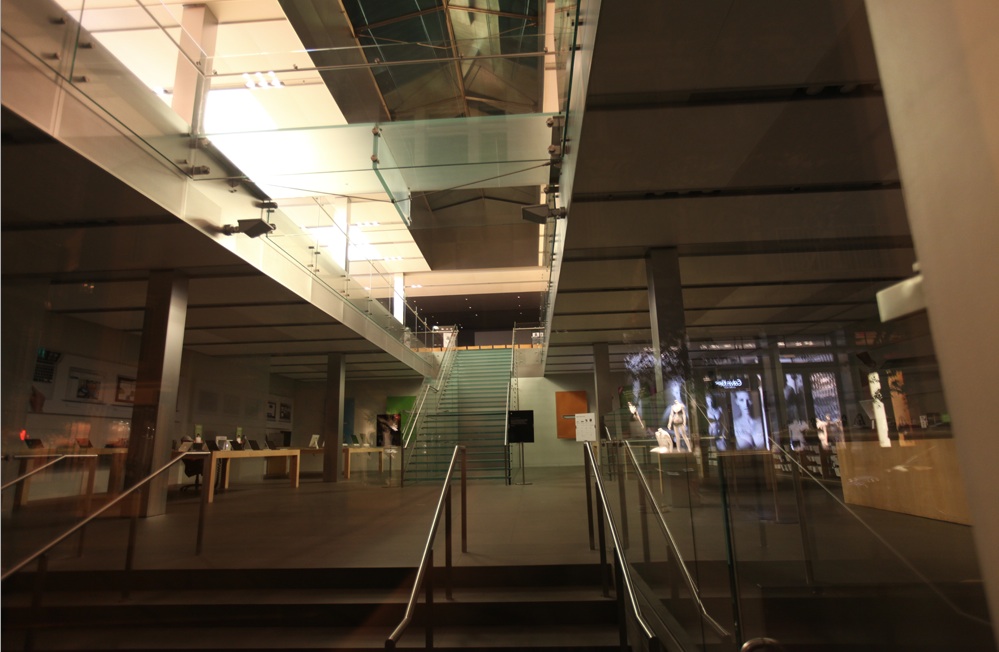
A typical Mac user is camping out even though there is no special event tomorrow.
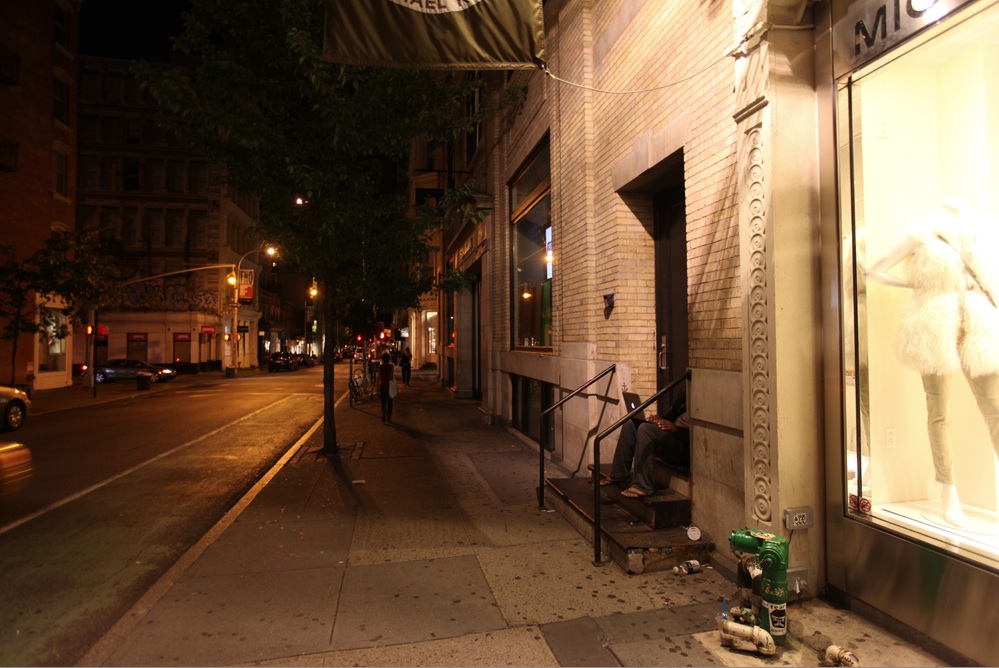
Blogging since 2002
The Apple store is eerily empty at night. It’s only populated by reflections from the other side of the street.

A typical Mac user is camping out even though there is no special event tomorrow.

There are two types of people in this world: those who say that crushed bedbugs smell like expensive Cognac, and those who say that Cognac smells like bedbugs.
I really wish the whole Apple antennagate would be over. Because I’m tired of explaining my position on it to everybody who drools over my iphone.
I have 3 points to make:
1) The office where I work has super ridiculously terrible ATT reception despite being in direct line of view from a brutalist style building containing ATT switches. So does an underground subway station where I change trains on the way to work. The rest of NYC has simply terrible ATT reception.
I’ve tried at the office, I’ve tried underground. I’ve tried cupping any which way. I tried moistening my palms. I can’t get to get a reliable bar drop thing. Sometimes, in fact, I got more bars. Oh, and that underground subway station? None of the older iphones ever had reception there.
This is all clearly a a product of me being a “fanboi”, and being under the heavy influence of Steve Job’s reality distortion field. I think they have mobile generators transmitting that.
2) Sometimes getting more bars when cupping iphone4 gives me an idea that now it is possible to make a case that will actually boost iphone reception by possibly attaching a yagi or another type of big directional antenna to the case. Maybe even something gigantic, like the apartment tower antenna or one of those huge homemade antennas that I used to make for crystal radios.
3) Right now I’m vacationing in the Ukraine. Here you can buy a sim card for $1 that gets you a phone number. On every corner there are agents and machines that allow you to refill these sim cards with ridiculously small amounts of money that get you ridiculously cheap minutes and data. There’s no standing in line while ATT employees are chatting / checking their social networks, scratching their asses, etc. There’s no hassle with forms, accounts, etc. You spend a little money, you get your phone to work. Most phones are unlocked. Reception is excellent everywhere. I hear they are working on making iPhone’s mini sims working with iPhones. People are ready to pay just about any price for the 4th iPhone. Apple would do much better with a simple business model: phones for money here first, and then in the US for us, who have to deal with ridiculous contracts and lock-ins. Grandstanding politicians would gain my vote if they did a little trustbusting in the cellular service industry.
If you think that cell phone toy that you bought your kid is cool, or remember the toy phone of your childhood, check this out – a set of toy phones out of 1927 Sears, Roebuck catalogue:
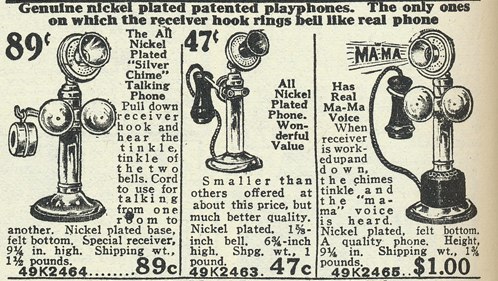
[3F11] Scenes from the Class Struggle in Springfield
Homer: [gasps] Look at these low, low prices on famous brand-name electronics!
Bart: Don’t be a sap, Dad. These are just crappy knock-offs.
Homer: Pfft. I know a genuine Panaphonics when I see it. And look, there’s Magnetbox and Sorny.
People often ask me why I refuse to buy Sony products. Indeed, I boycott Sony, and I am not the one to hold a grudge against evil multinational corporations. The level of incompetence on the high levels of Sony’s management disgusts me.
I used to be inspired by the story of Masaru Ibuka and Akio Morita starting a company in bombed Tokyo, and growing it from a radio repair shop into a giant corporation. I loved my Walkman, and thoroughly enjoyed the Playstation. I used to buy Sony Trinitron monitors which were brighter and sharper than the competition, but had visible horisontal lines formed by support wires made out of tungsten.
Over they years I felt that the quality of Sony products declined, while the company stopped to innovate and instead began to rely on brute force. They mostly missed the MP3 revolution. Instead they started to figh format wars.
The MiniDisk, the Memory Stick, Blu Ray: Sony would stop at nothing to control the format. They won with the CD and Blu Ray, lost with Betamax and just about everything else. None of these formats made me want to buy Sony products, and I’m very grateful that I don’t have to.
Sony would not stop at what’s legal – they even resorted to hacking their users’ computers – some Sony CDs installed rootkits on Windows machines in the name of copy protection! This is equivalent to breaking into your apartment just to make sure that you haven’t stole anything.
Normaly Hanlon’s Law is in effect, but I highly doubdt that things like these are benign byproducts of Sony being a large corporation. It seems like lawyers are doing a lot of thinking at Sony, and they aren’t thinking about winning people over.
Instead of trying to make their technology cooler, Sony through its lawyers started sending cease and desist letters to people who did things like making handmade iPod cases or toy racing cars out of outmoded Walkmen (I can’t find the original article mentioning the lawsuit about the racecars, but I remember reading it).
Then came the last drop. My wife runs a website about pipe organ event that she coded herself. She included an Amazon store that randomly showed different music-related items – it was a proprietory piece of software over which she had a rather limited control.
Sony employs a company called Net Enforcer that sends out DMCA takedown notices whenever they think they see any unauthorized “retailers” selling Sony products. My wife’s store’s algorithm used to include some Sony products sold by Amazon. Rather than dealing with the offending items, Dreamhost simply took down the whole store and notified me.
NetEnforcers would have you believe that they are protecting Sony’s brand, not letting various riffraff sell Sony products. I had to spend a good deal of time trying to figure out how to fix my wife’s store and not include any Sony products. As a result I refuse to buy any Sony brand electronics. I’m pretty sure this is not what Akio Morita would approve of.
If the Seal of New York City were designed today, it would not have a sailor and a Native American on it. It would have a cab driver and a food cart vendor.
Cab driving and food vending wood seem like the two of the most democratic enterpreneurial options, the foundation of which is the public streets New York City: you just wheel out your vehicle and try to make some commerce happen. The only thing that you need is a license. The one for cab driving is called a “medallion”, costs $766K, and as an investment vehicle outperformed just about any commodity and stock index. The food cart licesnses are also very expensive. Plus you are hounded by NYPD, Department of Sanitation, and who knows what else. Cab drivers and food cart vendors are some of the hardest working and most prosecuted businesmen in the city, but sometimes they have their own victories, big and small.
You don’t need to go any further than the Metropolitain Museum of Art to see two interesting examples. Right in front of the museum there’s a collection of food carts. They all are very typical carts, none of them are of the fancy variety. There are two types represented – the basic “dirty water hot dog” cars and “street meat” carts. But there’s one important difference – they all have stickers that say “Disabled Veteran”, and there’s usually an actual veteran somewhere nearby.

In the past years the space in front of the museum was either empty or occupied by one or two carts licensed by the Department of Parks. Then one day Dan Rossi, a disabled veteran, discovered a 19th century state law that allows disabled veterans to sell food in areas that are off-limits to others. The location in front of the museum is particularly lucrative because there are no affordable restaurants as far as an overweight tourist can walk. This hack is a small, but significant victory for food vendors. They are still ticketed mercelesly by NYPD, have to work crazy hours, and deal with the need to urinate in some kind of a miraculous way. At least they got an article in the New York Times written about them.
Across the road from the veteran’s carts is a mansion that belongs to billionaire Tamir Sapir, a former cab driver.
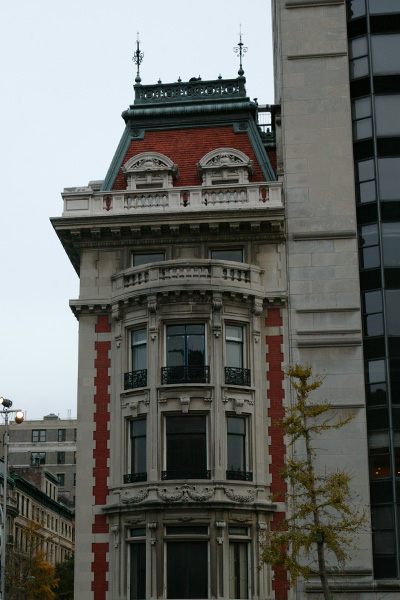
Mr. Sapir’s legend starts in Georgia, USSR. He found an interesting niche business: filling out complicated emigration forms for the Soviet Jews. At some point he was persuaded by his mother to give up his excellent life (it was a very lucrative business, from what I understand) and emigrate to Israel himself. He found himself in the middle of the Yom Kippur War, and quickly emigrated to the United States. He worked hard to earn enough money to leave rural Kentucky for New York, and then even harder to buy a cab medallion (which was a lot more affordable in those days). Then he risked everything again by putting up that medallion as collateral for a loan that he needed to open up an electronics store with a partner.
In the 80s there was a bit of a thaw in Sovet-American relations – Perestroyka and whatnot. There was a significant amount of people visiting the US – diplomats, scientists, sailors, and those invited by relatives. These people were allowed to exchange a small sum of rubles into dollars at the official rate – if I remember correctly, 60-something kopeks to a dollar.
What these lucky tourists wanted the most was electronics. In particular – vcrs, doule deck cassette players, and Walkmen. They had the money to buy these things, but here’s a problem: they needed 220 volt round plug devices, and more than that, VCRs needed to support the SECAM standard. You could not just walk into any store and find these: American market was all 110V and NTSC.
Every child in Odessa back then knew all of this, as well as that if you found yourself in New York City with some money, all you needed to do was trudge over to Timur’s (this was before he changed his name) store in Manhattan and find 220V SECAM VCRs.
Mr. Sapir was making a mint, but more importantly he was making connections with the Soviet ministers, diplomats, and future oligarchs. A little later he was invited back to the USSR, and made more connections there. These connections allowed him to play on the Soviet deregulation arbitrage market.
You see, when the Soviet Union was transitioning to the market economy all prices were regulated except those for commidities like metals, oil, and fertilizer. Those with connections could buy these commodities for already devalued rubles and sell them abroad for hard currency, making millions of dollars. All you needed was connections, which Mr. Sapir had.
He made millions, but the game became very dangerous as people tougher than NYC cabbies entered it. Mr. Sapir did not continue his career as a commodity exporter. Instead he invested his millions into New York City skyscrapers. The real estate market bottomed out, and you could buy a whole skyscraper for 10 million dollars or so. He bought a whole bunch of them. The price of Manhattan real estate exploded, and he became a billionare.
He bought a mansion across from the Metropolitain Museum to house his collection of carved ivory (for some reason this was a very popular area of collecting in the Soviet Union), has a yacht that used to be stuffed with a collection of exotic animal taxidermy that could rival Mr. Burn’s wardrobe or Amy’s car from Futurama.
Well, the two lessons here are: 1) you have to take risks and 2) you have to find a niche. The rest is luck.
I woke up from a nap to a loud pop and a smell of burning plastic. The source turned out to be one of the most precious and important to me digital devices: a ReadyNAS NV+, a small silver box with over a terabyte of hard drives that store my backups, music, and photos.
Network attached storage (NAS) is an engineering compromise. It’s a storage solution that lets you keep a bunch of drives in a self-contained device. It’s redundant: you can lose a drive (which is a statistical certainty) and not lose your data. There are also handy usb ports that let you connect usb drives and a button to run backup jobs onto these drives. It also serves as a print server, and in theory it can be used as a streaming media server. On the other hand it’s slow (gigabit networks are not fast enough when you need gigs of data fast), a complete nightmare to use with photo managers like Picasa, and an even worse nightmare if you want to use it as a Time Capsule.
I’ve spent a lot of time babysitting my ReadyNAS NV+: changing the defective RAM that it shipped with, updating the buggy firmware, finding the right drives for it (some don’t have the right temperature sensors). Don’t get me started on what it took to make it work with Mac’s Time Machine.
And after all that, the one box that was supposed to keep my precious digital archives safe was smoking. This was preceeded by a few days of weird performance issues and a couple of hangs. The power supply finally died a horrible death, and I realized that once again I was falling victim (or “mugu” as Nigerians say) to faulty capacitors.
According to Wikipedia, the name of this phenomenon is “Capacitor Plague“. There is an epidemic of failure in electrolytic capacitors from certain shady manufacturers. Electrolytic capacitors are usually found in power supplies. They are little aluminum cylinders filled with special film and electrolytic liquid or gel. Power supplies get very hot, and the liquid part of the capacitors, the electrolyte, always wants to either dry up or explode. The formula for the electrolyte is very hard to get right.
The rumor is that one or a few companies resorted to industrial espionage to steal electrolyte formulations. They weren’t entirely successful – they either got an incomplete formula or just plain Brawndo.
Spectrum Online did some digging:
“According to the source, a scientist stole the formula for an electrolyte from his employer in Japan and began using it himself at the Chinese branch of a Taiwanese electrolyte manufacturer. He or his colleagues then sold the formula to an electrolyte maker in Taiwan, which began producing it for Taiwanese and possibly other capacitor firms. Unfortunately, the formula as sold was incomplete.
“It didn’t have the right additives,” says Dennis Zogbi, publisher of Passive Component Industry magazine (Cary, N.C.), which broke the story last fall. According to Zogbi’s sources, the capacitors made from the formula become unstable when charged, generating hydrogen gas, bursting, and letting the electrolyte leak onto the circuit board. Zogbi cites tests by Japanese manufacturers that indicate the capacitor’s lifetimes are half or less of the 4000 hours of continuous ripple current they are rated for.”
Wastefulness of today’s society masks the problem: most people don’t perform autopsies on their dead $70 DVD players or $500 computers, they just use that as an excuse to buy the new hottness. The techies with (or without) spare time and soldering skills do the following: fill bulleten boards with tales of saving their devices by soldering in new capacitors; search for instructions on how to solder and purchase capacitors; and curse creatively after doing it for the 5th time.
The unique thing about the capacitor plague is how easy it is to identify: the capacitors literally blow their tops, venting electrolyte through the special stress relief indentations. It’s also unique in that anybody with a soldering iron has a very good chance of fixing it: the caps are easy to locate and solder. In the age when most electronic components are of the “surface mount” type (the size of a sesame seed) or chips with dozens legs as fine as silk, soldering in a two legged capacitor is very refreshing.
Here’s a nest of capacitors from my busted power supply: two in the left corner are clearly popped, the one on the right is probably ok:

In the last couple of years the following devices that I own fell prey to faulty caps: a cheap off-brand dvd player, a speed control on my Dodge Caravan’s air conditioner, a Netgear network hub, a huge and expensive Air King window fan, and now, my ReadyNAS. The interesting thing is that the problem exists in both high end and low end products, as well as in high tech and low tech ones (I did not know there were electronic components in the window fan).
I am out of warranty on my ReadyNAS because I bought it in May of 07. The following passage leads me to believe that the shitty capacitors are a problem that they are aware of and (maybe) fixed in newer releases of the hardware (they could not offer a 5 year warranty if they used the same capacitors – they’d just go broke).
“Please be aware that ReadyNAS purchased prior to August 21, 2007 carries a one-year limited warranty. Extended warranty purchased for these ReadyNAS will be honored by NETGEAR. ReadyNAS NV+ and 1100 purchased August 21, 2007 and later have a 5-year limited warranty, and the ReadyNAS Duo has a 3-year warranty.”
The brand name of the popped capacitors reads “Fuhjyyu”. It lead me to the an urban dictionary entry that says that Fuhjyyu is either
“1) Chinese word for feces.
or
(2) Brand name of abysmal quality capacitors that are installed on logic boards, switching power supplies and various other electronic components.”
There’s also a post from a guy who implores ReadyNas to stop using those capacitors.
Then there’s badcaps.net – a global capacitor gripefest that is too depressing to read.
You can see a nice gallery of busted caps over here
There are broader implications of this: coupled with the fragile lead free solder, leaky capacitors don’t only cause kajillions of dollars of damage, but will also make electronics of our era impossible to use in the near future. The aluminum in burnable cds and dvds are rotting too, destroying the record of our time.
People walking by my cubicle often pause and look at a picture hanging on my wall. It’s of an old lady in what looks like a meter maid’s uniform. Who is she? Why is this picture so important to you? – they ask.
The picture, of course is of one of the two patron saints of software developers, Rear Admiral Murray Grace Hopper. Admiral Hopper is an old school hacker, mother of Cobol, popularizer of the term “bug”. There is a missile destroyer named after her, her personal motto is very close to my heart, and she looks a little bit like my grandmother (who happened to be a mechanical engineer).
The second prominent woman in software is Augusta Ada King, Countess of Lovelace, and a celebration of her life is the reason I am writing this post. Countess Lovelace is famous for grokking what computer programming was all about back in Victorian era, and therefore is often reffered to as the first programmer. If I’ll ever make it out of a cube into an office, I’ll comission an oil portrait of Ada Lovelace and hang it there.
There aren’t many accomplished women in technology as these two, so someone came up with an idea of celebrating Ada Lovelace’s birthday by getting people to write blog posts that will draw attention to women excelling in technology. I chose to write about Temple Grandin. I would have written about my grandmother, but unfortunately I don’t know much about her life’s work.
I learned about Temple Grandin from an article in Wired magazine called “The Geek Syndrome“. It was an article about an explosion of cases of autism and Asperger’s syndrome in hotbeds of technology such as Silicone Valley. This article and Temple Grandin’s books, “Thinking in Pictures” and Emergence: Labeled Autistic made me see myself and other techies in a completely different light. I am convinced that some level of autism is what makes people get involved in technology. Being a geek is a bit like having homosexual sex: anybody can do it, very few try it, and only a minority enjoy it and are good at it.
According to wikipedia “the word geek is a slang term, noting individuals as “a peculiar or otherwise odd person, especially one who is perceived to be overly obsessed with one or more things including those of intellectuality, electronics, etc.”[1] Formerly, the term referred to a carnival performer often billed as a wild man whose act usually includes biting the head off a live chicken, bat, snake or bugs.” Indeed, geeks are strange people. They obsess about things, they have unusual interests, they are incredibly detail-oriented. All of these traits are considered by psychologists to be symptomes of Autistic Spectrum Personality disorder or ASD. “Impaired social interaction and communication” – another geeky/autistic trait.
“The prevalence of ASD is about 6 per 1,000 people, with about four times as many boys as girls” – also, according to Wikipedia. Eerily, this seems to be more or less in line with overall percentage of people involved in technology and the male/female ratio.
A human mind is a self-aware and self-adjusting multi-level software/hardware combination, and that makes it very hard to talk about the nature of brain disorders. Autism is particularly tricky: it is a spectrum. People with autism range from those severely afflicted and non-verbal through hundreds of different gradations to a geek with strange hobbies and social interaction problems. Yet it is the same basic thing: some kind of overdevelopment of some areas of the brain and underdevelopment in others, as well as a difference in processing sensory input.
Temple Grandin started out a severely afflicted autistic child, pretty close to the upper end of the scale. She recoiled from being hugged, started speaking very late, had all kinds of behavioral problems. Even with her high IQ nobody expected her to become a very succesful professional. She was lucky in having parents who sent her to a specialized school, and some teachers who channeled her obsessions into productive direction. She describes herself as a “recovering autistic.”
Her professional success is tremendous. She became a foremost expert in livestock handling equipment. Before her the livestock industry did not pay a lot of attention to the way animals were handled and transported. Existing structures used to shuffle livestock from a place to a place had design flaws that would cause animals to balk and refuse to move. This caused unnecessery use of force, stressing the animals and their handlers, costing farmers and processors a lot of time and money. Temple Grandin’s attention to detail allowed her to figure out very subtle causes of animal’s discomfort (autistic people are frequently bothered by minute changes in their environment) and figure out better ways to handle them. It’s very likely that all of us at some point drank milk or ate a steak from a cow that went through a facility designed by Dr. Grandin.
Autism seems to be a hardware-based disorder, something to do with neuron distribution and signal sensitivity. The curious part about problems like that is that they sometimes can be fixed with a software patch and changing some external factors. For instance, if you have a defective computer processor that starts generating errors from overheating, you can fix it by writing error-checking software and cooling it down with a fan.
After seeing a squeeze chute used to calm down cattle, Temple Grandin ivented a so-called hug machine, a device that applies a deep body pressure and through it makes autistic people feel better.
In his book Jpod, Douglas Coupland describes how one cubicle dwelling game developers builds a hug machine. After some ridicule and a few tryouts the machine attracts a long line of software developers wanting to use it. I wonder if any of the Google offices have one. I, personally, find that taking a long bath or wrapping very tigtly in a blanket always calms me down. Even better is diving: I get an unusual sense of calm from it.
Dr. Grandin’s books opened my eyes to the traits of “engineer’s affliction” and allowed me to better understand myself and my fellow geeks. Here’s a short list of the autistic traits that you might find in most software developers:
* Liking to create lists
* Lack of eye contact
* Stimming: repetitive behaviors like rocking in a chair
* Strange patterns of speech
* Ranting, long speeches about obscure topics
* Excruciating attention to detail
* Love of routine, dislike of change
* Love of symbols
* Obsessions with obscure things
* Superior pattern recognition
* Visual thinking
* Liking things more than people
* Bouts of anxiety, especially in social situations
Wired has a test designed by Simon Baron-Cohen (Borat’s brother) – you can see how many typical autistic traits you have. My score is 31.
The good part is that autistic obsessions can be “cashed in” for professional success in technological fields. Think about the level of obsession or concentration necessary to design a computer processor like this one? On the other hand, Dr. Grandin’s books showed me that it is possible to work on problematic traits, like eye contact and social awkwardness. Human minds are strange loops, capable of understanding, rewriting and fixing themselves.
Here’s a list of books that I recommend for better understanding of techies, male and female:
* Thinking in Pictures: And Other Reports from My Life with Autism and Emergence: Labeled Autistic by Temple Grandin
* Jpod and Microserfs by Douglas Coupland
* A Spot of Bother and The Curious Incident of the Dog in the Night-Time by Mark Haddon.
What do I buy: a cleaning robot, an e-ink powered ebook, or a personal genetic test from 23andme.com? This is one of those terrible trilemmas facing geeks who are not willing to sacrifice financial stability for having all the coolest gadgets. I chose a 23andme test, and haven’t regretted it.
The factoid that always is mentioned in the press about 23andme is that its co-founder Anne Wojcicki is married to Google co-founder Sergey Brin. This of course means that the data that 23andme is collecting is going to be used to help Google’s Skynet to gain the upper hand in the forthcoming war.
23andme’s service works like this: you give them some money (at the time when I write this the price is $399, but it used to be over $800), they send you a test tube into which you spit, some special preservative solution, and a return envelope. You follow some simple instructions and send your spit to a processing facility. Then you wait (this is the hard part). In a month or so (it depends how long the backlog of orders is) you recieve an email telling you that you can log into 23andme.com and take a look at the results.
The processing that they do in the lab creates a data file that represents an impressive number of genetic data points called SNPs or single-nucleotide polymorphisms. The way I understand it, SNPs are known variations that happen in DNA sequences. Much of the DNA stays the same for all people, but there are some variations in a single location. Let’s say there’s a string of DNA in humans that goes
G-A-T-T-A-C-A
C-T-A-A-T-G-T
and 6 positions there are the same for everyone, except the seventh, which is sometimes AT and sometimes GC. So basically it’s a single position on the one of the 23 chromosomes or mitochondrial DNA (I guess 23andmitochondriaandme was shot down as a possible name for the company) that statistically is different from person to person as opposed to long stretches of DNA that stay the same.

Scientists all over the world are studying the correlations that SNPs have with disease risks and traits. I guess these studies go something like this: you grab 500 programmers that use emacs editor and 500 that use vi. You have a hunch that editor preference is related to gene C4711. You sequence the dna of all your coders looking for SNPs in the gene C4711 that are one way in your vi-using alphas and another way in emacs-using sub-omegaloids. Then you find that in most of vi users SNP rs1729 is AA. Then you come out and say – AA in s1729 increases the odds of a programmer preferring vi by 47%.

The more people that a study has – the better the results. 23andme has genetics experts on staff that sift through mountains of these studies, rank them, and then tell the website people to add results to the interface. This way you can go to 23andme.com and see (as of right now) that tell you right away what your lifetime chances of getting 10 diseases. Some, like Parkinson’s, they don’t let you see without you agreeing to see it yourself. Sergey Brin was reported in the media to get some bad news from that particular one (mine came back “Typical Risk” which means that my chance of getting Parkinson’s is about 1.6%, same as everybody else).
A lot of people that I talked to about genetic testing told me that they’d “rather not know”. It’s true that some of the things that you might learn will make you worry without being able to do anything about it. On the other hand, there are some that you might be able to do something about.
“24.1 out of 100 people of European ethnicity who share this genotype will get Prostate Cancer between the ages of 35 and 79” vs “17.8 out of 100” on average. Here I learned that I have about 1 in 4 chance of getting prostate cancer. Prostate cancer is one of the relatively treatable ones if caught early, but with unpleasant diagnostic procedures. All of a sound “digital exam” does not sound so bad, and I guess I’ll have to bend over and cough a lot more often than I otherwise would. I’m not sure what coughing does, but the “digital” part has nothing to do with electronics or numbers.
There are also 10 traits that are available right now. The most interesting one for me was “Resistant to infection by the most common strain of HIV people usually encounter, though protection is not complete”. I apparently have two copies of something called “Delta32 version of CCR5”. “Although people with two copies of Delta32 are highly resistant to the most common type of HIV, they can be vulnerable to strains of the virus that do not use CCR5 to enter immune cells”.
This makes me a little bit more at ease when I donate blood, even though I know that the chances of getting infected with AIDS at a blood donation are already less than winning that Mega jackpot. On the other hand Dr. Asimov died of AIDS that he received through a transfusion. What’s more interesting, is that this is the same mutation that prominently figured in the media with the AIDS patient who was cured through a bone marrow transplant.
Then there’s a section that has 79 research reports. These get a rating fоr “research confidence”. I, for instance, have an elevated risk of obesity from research that has a three star rating.
Doctor House would have loved getting access to this kind of data for every one of his patients. There are risks for rare diseases mentioned on the show Ankylosing spondylitis, Hemochromatosis, Bloom’s syndrome, and everybody’s favorite – Lupus (which it’s never).
One of the tests included in 23andme is for muscle performance, the one that was in newspapers lately because it was offered by a few companies. The news angle was that sports obsessed parents paid hundred of dollars to find out if their kids have sprinting or marathon ability. Mine says: “One working copy of alpha-actinin-3 in fast-twitch muscle fiber. Many world-class sprinters and some endurance athletes have this genotype.” This sounds plausible – for a fat dude I have an uncanny ability to sprint, yet suck at long distances.
But wait, this is not all. For the same low price you also get some ancestral info. This comes in a form of maternal and paternal haplogroup. I am not sure I understand the what haplogroup is very well, and found 23andme’s infographics somewhat confusing. From what I understand a haplogroup is a number that is attached to a certain mutation (a few SNPs maybe?) that arose thousands of years ago and that has been statistically crosslinked to people living in certain geographical locations.
My paternal haplogroup is E3b1c1* – “populations: Ethiopians, Jordanians, Ashkenazi and Sephardic Jews”. My maternal haplogroup is H5a* – “populations: Lebanese, Polish, Irish”. Both of my ancestral branches are supposedly Ashkenazi, and I guess haplogroups are not a high enough resolution to prove or disprove Jewish ancestry. All they do is tell you that the progeny of your very remote ancestor was likely found in certain wide geographic locales “before the era of intercontinental travel.” What’s interesting is that there’s a small chunk of my maternal haplogroup’s population in Siberia.
23andme is a true Web 2.0 service (in the good sense of that expression). There’s a blog called The Spittoon. In between educational (sometimes interesting, sometimes boring) posts about genetics they have a section called “SNPwatch“. There they write about new research and usually provide a link to raw data in your 23andme profile. So for instance there was an article titled “Variants in Genes for Carcinogen Transporters Linked to Lung Cancer” about a mutation that prevents lungs from clearing out cancer-causing chemicals. Then you can click on two links and see if you have that mutation (to my relief I don’t).
There are some social network features: you can compare your DNA profile to your relatives. I’m not sure if hilarity might ensue because I think you can figure out possibility/impossibility of paternity and maternity, like Dr. House did in that episode. You can even compare your DNA to other users of 23andme – you have to accept a “friend” request for that. I’m not really sure what’s the fun in that. You can participate in surveys that might be used for research (there isn’t one yet about vi vs. emacs yet, but there are some other ones).
It does not look like the $400 fee even covers the cost of gathering the data (there no further fees as of now) or paying for staff/website maintenance, and ongoing research. I’m not really sure what the business model here is (and that makes me a little nervous. Businesses like this remind me of an old Yiddish joke:
Moyshe is selling boiled chicken eggs. He buys them for a kopek each and sells them for a kopek each. Chaim asks – “Moishe – where’s the profit in this?” “What, are you stupid?” – answers Moyshe. “I get to keep the broth”.
My guess is that the “broth” here is an opportunity to conduct groundbreaking research and maybe sell the anonymized data. That, and helping Google’s Skynet find and assassinate John Connor.
I don’t really worry too much about being denied insurance in the grim meathook future that surely is coming just because I used 23andme. There’s legislation against that on the books right now, and if insurance companies will be able to deny coverage based on genetics they’ll be much more likely to get this info by requiring a blood test.
I really wish I could get the data from my grandparents (none of whom are sadly alive). I will buy kits for my entire family though as soon as I’ll be willing to part with another chunk of disposable income (I do want that dang Kindle first though).
I live on a high floor of an art deco tower facing a busy Brooklyn street. The acoustics of the building and the street are such that I can sometimes hear what’s going on in the street right from my desk. Once I heard the sounds of a minor fender bender followed by an angry exchange unpleasantness that was escalating into some creative Russian profanity. The driver who rammed the other car was pretty unapologetic and criticized the driving skills of the one who got rammed. Then followed the exchange that made me laugh out loud – the driver who got rammed said – “the way you behave, man, you must be from Odessa.” “Yes, I am,” – answered the other guy, and added – “and you still drive like a moron.”
Odessa, Ukraine, my hometown, is a very special place. It has a Bizarro mirror twin, Odessa, Texas.
Odessa is a resort town situated on the shore of the Black Sea, right across from Turkey. Culturally it’s a bit like Brooklyn (or Brooklyn is a bit like Odessa because of an almost constant infusion of Odessans) – a city with an attitude, a city where a lot of famous people are born and famous people come to live. Architecturally it’s a lot like Vienna and St. Petersburg: a city built on a grand scale (but with softer edges), by the best architects.
Odessa’s ancient past is obscure: a Greek colony, a small town controlled by Kievan Rus, the Golden Horde, various Khanates and Kaganates, and finally a Turkish fortress. Odessa’s fortunes have turned when Russian forces invaded it in late 1700s. Catherine the Great apparently wanted to fortify the newly won land, and committed the people and resources needed to make the new city of Odessa a success.
The founding fathers of Odessa were a bunch of distinguished foreigners in the service of the Russian crown: General José Pascual Domingo de Ribas y Boyons, Armand Emmanuel Sophie Septemanie du Plessis, duc de Richelieu, and Count Louis Alexandre Andrault de Langéron.
Richelieu, or the Duc, as he’s commonly known in Odessa, will forever be loved by Odessans for his accomplishments. The way I imagine the Duc is sort of like the 18th century Steve Jobs, with a reality distortion field of his own, except without being an asshole (Richelieu was known for his kindness and indifference to money). Somehow – nobody know exactly how – Richelieu got Odessa the status of a “free port“. This meant that goods could be unloaded without paying the taxes within the city limit. This brought about an unprecedented influx of wealth, which in turn fueled the building of Odessa by the best European architects in the European manner. Odessa’s opera theater is only slightly smaller than Vienna’s, and is by the same architect.
Another unique aspect of this new city was the ethnic makeup. Besides the usual for Ukrainian cities mix of Ukrainians and Russians, Odessa became a melting pot. Frenchmen, Greeks, Turks, Germans, Armenians: all rushed into Odessa. Even the Jews were allowed in, and not being limited to certain occupations or living in a ghetto. Odessa is a very Jewish town despite what the author of Everything Is Illuminated might have you believe.
I left Odessa when I was 16. I came back for a 10 day visit 15 years later.
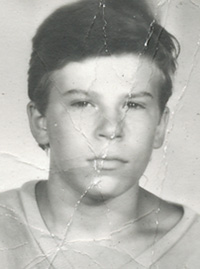

Odessa is a a city that makes you nostalgic, and I kept seeing it in my dreams. Luckily there’s a small international airport in Odessa and President Yushchenko kindly lets the holders of an American passport into the country freely, with no need for a visa.
12 hours and $1300 later I was standing in Odessa, looking for a cab. A pushy cabby was very surprised when I did not want to ride in his clean BMW and chose a cheaper and dearer to my heart filthy Soviet-vintage car.
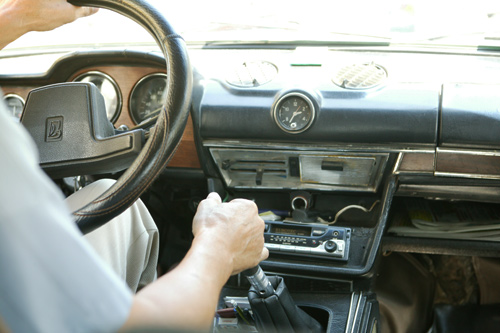
As far as hotels go, Ukraine is much more reasonable than Russia, but there are still no Marriott-like affordable and well-designed chains. There are overpriced hotels with decor that will burn your eyes out, cheaper, but scarier hotels, and apartments that you can rent which cover the gamut. Odessa has a population of about a million, but it swells to twice the size in the Summer season. Because of that there are thousands of very reasonably priced rental apartments with great amenities. Unfortunately I did not plan enough ahead, and ended up reserving a very cheap room in a brand new hotel Zirka that recently opened right in the center of the city.

For a very reasonable $35/night I lived in a tiny-tiny, somewhat flimsily outfitted, but very clean room with a fully functioning shower, air conditioning and beautiful views, right in the historic center of Odessa.
The hotel was still being built when I lived there, and I herd later that it was becoming a bit notorious for renting the rooms at hourly rates.
As far as I’m concerned, you really can’t beat their amenities, their location, and their prices. Also, the staff was very courteous and professional. It was very quiet there during my stay – but worst case scenario – you might overhear noisy sex, from which you are not guaranteed at almost any hotel.
It’s hard to see on picture, but the towels had little dollar sign designs.
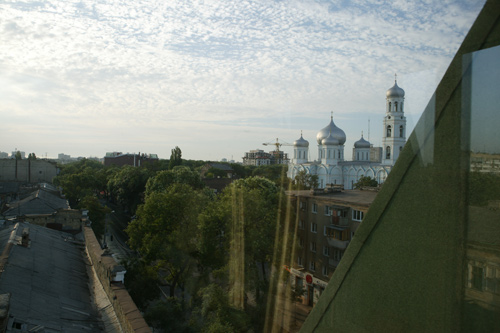
My hotel room reminded me very much of the affordable hotel room that I lived in in Japan, down to the picture of soft drinks that I took there.
In Odessa I mostly drank Borjomi, a Georgian mineral water. Borjomi, as far as I’m concerned is the tastiest mineral water in the world.
Odessa has its own mineral water, Kuyalnik, but it’s not sold in restaurants for some reason. I found a few bottles in a convenience store closer to the end of my stay. More about Kuyalnik later – I have a very special connection to it.
Apparently in Europe Diet Coke is marketed as Coca Cola Light, is sold in frosted bottles, and as far as I can tell, in a different formulation. It did taste different, and I know my cokes.
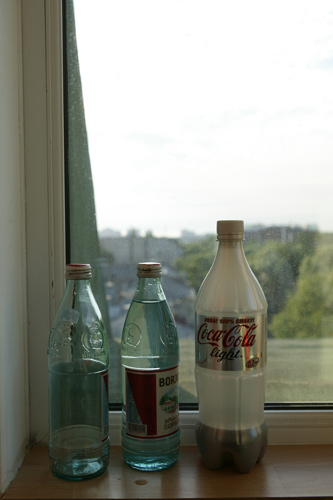
I quickly unpacked, grabbed my camera and went for a walk.
You really can’t enter the same river twice. I left Odessa when the Soviet Union was still intact. When I came back, a lot of things stayed the same.
There’s still a fountain in the City Square, the live band is still playing on Sundays and the pairs still dance.
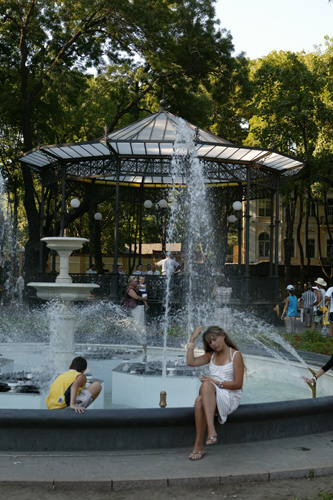
Acacia trees, the most common plant and the symbol of Odessa, are still filling the city with the aroma and sidewalks with their yellow flowers. Cleaning ladies (and men) still sweep the sidewalks with brooms made out of small branches. I brought a small jar with acacia blooms with me – the smell of nostalgia.

Remember that ethnic markup that I described earlier on? Well, somehow that mixing of genes resulted in the hottest women on the planet. Odessa is still the city of super hot women. This brings a large contingent of sex tourists and mail order (in this case – cash and carry) bride seekers. I was approached (probably because I was typing away on a laptop) by a most distressed gentlemen in a cafe: he could not get online. His hands were shaking. I fixed some gnarly windows crud setup options and wi-fi started working. All he cared about was getting to a dating site, and when it loaded, his hands finally stopped shaking.

Things have changed though. Odessa took on some qualities of Havana, Cuba. Historic buildings are deteriorating, old cars are kept alive way past what’s reasonable.
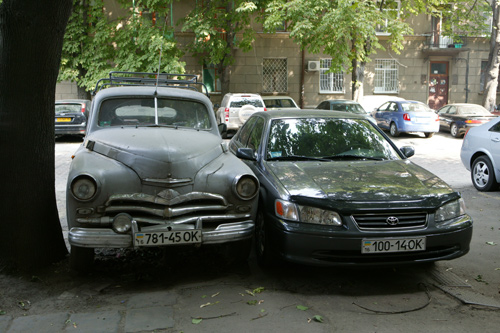
It’s not like Havana because people seem to prosper. Even the pensioners do not go hungry, there is a lot of new construction, and the rich are really, really rich. I’ve seen just about every expensive car I know in the streets, except maybe a Maybach.
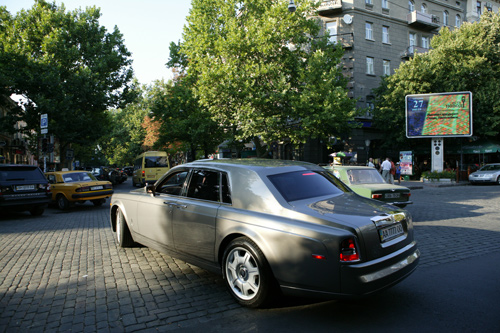
A few things about the new Ukrainian economy. The salaries are paid in US dollars, but dollars are not accepted anywhere. You can easily exchange them into hryvnas and back very easily, and the rate is somehow kept at about 5 to 1, without even having to shop around for a rate.
Real estate is amazingly expensive: for instance the apartment that my parents sold for something like $5K costs about $500K. At the same time the mortgage industry is almost non-existent.
I’m told that the government officials are amazingly corrupt, and they constitute a major portion of the upper crust. A police captain can easily become a multimillionaire, and so can just about any government bureaucrat. There’s a practice of “otkat” – kickback from a government project is rampant. High ranking policemen and bureaucrats are almost outside the law, like in India.
At the same time, even with all the corruption and bribery, the economy is pretty healthy, even without Russia’s oil.
Price-wise Odessa is not the bargain that it once was. For most things I’d estimate the cost of living at about 60-70% of Brooklyn prices. Food and rent is pretty cheap, but electronics, clothing and cars are more expensive. In particular, cars are taxed so much that they cost about 2 to 3 times more than in the US, which makes all those Rollses that I’ve seen even more impressive, and explain the Soviet-era cars.
Deadprogrammer Visits Odessa : Part II : Balconies and Yards.
Pilot: Welcome to Japan, folks. The local time is…tomorrow.
The Simpsons, Thirty Minutes Over TokyoIf you want to know what Japan is like architecturally, go watch Samurai Jack cartoons. The future world created by Genndy Tartakovsky looks a lot like present day Japan.
I picked some photos of buildings to give you a general idea of what I have seen. Here’s a Habitrails-inspired otaku-infested electronics shop in Akihabara.
Here’s a very elegant Stalinist-style skyscraper somewhere in Tokyo.
Philippe Starck blemished Tokyo skyline with a giant golden turd on the top of Asahi Beer Hall. It’s supposed to symbolize a flame that in turn is supposed to symbolize the company spirit of Asahi. Giggling tourists take a lot of pictures with creative shot framing. By the way, I’ve tried a lot of different beers that Asahi makes, and they all taste like, uh, flame. I, personally like Sapporo much better.
The Japanese society is highly stratified. For instance, in the hotel complex where I was staying there were at least 5 different classes of buildings (each of a different prestige level) and the ANA plane in which I travelled also had 4 or 5 types of seating. On this picture you can see two layers of Japanese society: well-designed plastic huts built by homeless with a backdrop of what I’m told is company-provided employee dorms.
Here’s an amazingly eclectic little building (I think it’s a firehouse). It combines elements of Art Deco, Modernism and traditional Japanese architecture.
And this building is pretty typical of modern designs. I love the huge wrap-around windows, the dna-like staircase and the efficient use of space.
I was most shocked by architecture in Kyoto’s Gion, the geisha district. Near all-traditional Japanese buildings there was a number of super-futuristic mostly metal buildings that looked like spaceships. I think they were nightclubs of some sort. I’ve never seen anything like this anywhere else.
Many building tops had antenna clusters, one more cyber-punkey than the other.
As we all know, land is pretty tight in Japan. Here’s a pretty typical small house somewhere in Kamakura (I think).
What makes construction in such tight quarters possible is this marvel of technology: a cute pocket-sized excavator.